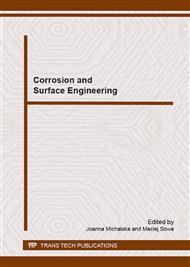p.463
p.467
p.471
p.475
p.479
p.483
p.487
p.491
p.495
Effect of the High Voltage Anodic Oxidation on the Titanium Corrosion Resistance
Abstract:
The paper describes anodic oxidation of titanium surface in a potential range from 30 to 240 V in a 2M H3PO4 electrolyte with the addition of 0÷2 % HF. The aim of the treatment was to form titanium oxide with a developed, rough morphology, useful for biomedical application. The morphology of the anodically oxidized samples was examined using SEM and AFM. The phase structure of the oxides was determined by XRD. One of the main parameters determining the suitability of that material for biomedical application is the corrosion resistance in an environment comparable to human body (Ringer’s solution). It has been observed that corrosion resistance of the anodized surfaces increases with the increase of the anodizing voltage for the samples oxidized in an electrolyte containing 0 % and 0.2 % HF. In electrolytes with the addition of 1 % and 2 % HF an inverse relationship was observed. The corrosion resistance of all tested surfaces was sufficiently high for the application as a biomaterial. The most promising anodizing treatment, providing best surface morphology and corrosion resistance was performed at 210 V in a 2M H3PO4 + 1 % HF electrolyte.
Info:
Periodical:
Pages:
479-482
Citation:
Online since:
January 2015
Authors:
Keywords:
Price:
Сopyright:
© 2015 Trans Tech Publications Ltd. All Rights Reserved
Share:
Citation:


